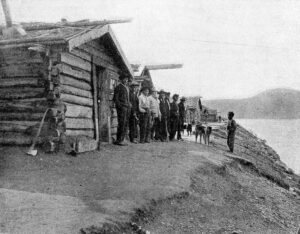
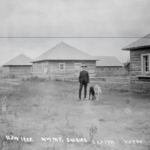 Fort Selkirk was built as a trading post on the Yukon River at the junction of the Pelly River in Canada’s Yukon. For many years it was home to the Selkirk First Nation, also known a Northern Tutchone. The Selkirk First Nation is a First Nation self-government in the Canadian territory, Yukon. “First Nation self-government is a formal structure through which Indigenous communities may control the administration of their people, land, resources, and related programs and policies, through agreements with federal and provincial governments. It is about First Nations taking greater control over and making their own decisions about matters that affect their communities within the Canadian constitutional framework. First Nations have their own governments with responsibilities, structures, resources, and taxation powers similar to other municipal or territorial governments in Canada. These First Nations are guided by their Final Land Claim Agreements, Self-Government Agreements, and Constitutions.” I suppose this would be similar to the Indian Nations in the United States, who are government entities in their own right.
Fort Selkirk was built as a trading post on the Yukon River at the junction of the Pelly River in Canada’s Yukon. For many years it was home to the Selkirk First Nation, also known a Northern Tutchone. The Selkirk First Nation is a First Nation self-government in the Canadian territory, Yukon. “First Nation self-government is a formal structure through which Indigenous communities may control the administration of their people, land, resources, and related programs and policies, through agreements with federal and provincial governments. It is about First Nations taking greater control over and making their own decisions about matters that affect their communities within the Canadian constitutional framework. First Nations have their own governments with responsibilities, structures, resources, and taxation powers similar to other municipal or territorial governments in Canada. These First Nations are guided by their Final Land Claim Agreements, Self-Government Agreements, and Constitutions.” I suppose this would be similar to the Indian Nations in the United States, who are government entities in their own right.
The trading post of Fort Selkirk was the hub of the community, allowing the buying, selling, and trading of 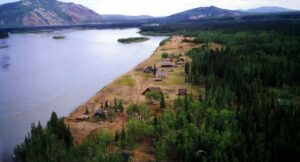 items needed for everyday life. Most of the people lived nearby, but these days, most of its citizens now live in Pelly Crossing, Yukon where the Klondike Highway crosses the Pelly River. The original language of the people was Northern Tutchone. These days, there is an effort to ensure that the language and culture are not lost. Archaeological evidence shows that the site has been in use for at least 8,000 years.
items needed for everyday life. Most of the people lived nearby, but these days, most of its citizens now live in Pelly Crossing, Yukon where the Klondike Highway crosses the Pelly River. The original language of the people was Northern Tutchone. These days, there is an effort to ensure that the language and culture are not lost. Archaeological evidence shows that the site has been in use for at least 8,000 years.
In 1848, Robert Campbell established a Hudson’s Bay Company trading post nearby, and in early 1852, he moved the post to its current location. This caused a lot of resentment due to the interference of the Hudson’s Bay Company with their traditional trade with interior Athabaskan First Nations. So, on August 21, 1852, the Chilkat Tlingit First Nation warriors attacked and looted the post. For a time, after the attack, the fort was in ruins. It was rebuilt about 40 years later and once again became an important supply point along the Yukon River.
The fort was basically abandoned again in the mid-1950s, after the Klondike Highway bypassed it and Yukon River traffic died down. These days it would be considered a ghost town I suppose. Nevertheless, many of the 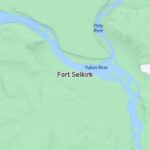
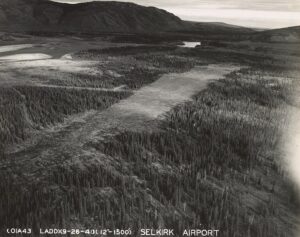 buildings have been restored and the Fort Selkirk Historic Site is owned and managed jointly by the Selkirk First Nation and the Yukon Government’s Department of Tourism and Culture. That doesn’t mean that it has become a tourist hub, because the fact remains that there is no road access to the site. Most visitors get there by boat, though there is an airstrip, Fort Selkirk Aerodrome, at the site. A person would have to have a specific reason for going to the site, or they would be unlikely to make the journey.
buildings have been restored and the Fort Selkirk Historic Site is owned and managed jointly by the Selkirk First Nation and the Yukon Government’s Department of Tourism and Culture. That doesn’t mean that it has become a tourist hub, because the fact remains that there is no road access to the site. Most visitors get there by boat, though there is an airstrip, Fort Selkirk Aerodrome, at the site. A person would have to have a specific reason for going to the site, or they would be unlikely to make the journey.


Leave a Reply